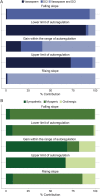Pathophysiologic differences in cerebral autoregulation after subarachnoid hemorrhage
- PMID: 27164675
- PMCID: PMC4887123
- DOI: 10.1212/WNL.0000000000002696
Pathophysiologic differences in cerebral autoregulation after subarachnoid hemorrhage
Abstract
Objective: To understand the physiologic basis of impaired cerebral autoregulation in subarachnoid hemorrhage (SAH) and its relationship to neurologic outcomes.
Methods: The cohort included 121 patients with nontraumatic SAH admitted to a neurointensive critical care unit from March 2010 to May 2015. Vasospasm was ascertained from digital subtraction angiography and delayed cerebral ischemia (DCI) was defined as new cerebral infarction on high-resolution CT. Cerebral blood flow and beat-by-beat pressure were recorded daily on days 2-4 after admission. Autoregulatory capacity was quantified from pressure flow relation via projection pursuit regression. The main outcome was early alterations in autoregulatory mechanisms as they relate to vasospasm and DCI.
Results: Forty-three patients developed only vasospasm, 9 only DCI, and 14 both. Autoregulatory capacity correctly predicted DCI in 86% of training cohort patients, generalizing to 80% of the patients who were not included in the original model. Patients who developed DCI had a distinct autoregulatory profile compared to patients who did not develop secondary complications or those who developed only vasospasm. The rate of decrease in flow was significantly steeper in response to transient reductions in pressure. The rate of increase in flow was markedly lower, suggesting a diminished ability to increase flow despite transient increases in pressure.
Conclusions: The extent and nature of impairment in autoregulation accurately predicts neurologic complications on an individual patient level, and suggests potentially differential impairments in underlying physiologic mechanisms. A better understanding of these can lead to targeted interventions to mitigate neurologic morbidity.
© 2016 American Academy of Neurology.
Figures



Comment in
-
Cerebral autoregulation in acute SAH: The more we know the better?Neurology. 2016 May 24;86(21):1936-7. doi: 10.1212/WNL.0000000000002708. Epub 2016 Apr 22. Neurology. 2016. PMID: 27164687 No abstract available.
References
-
- Barth M, Capelle HH, Munch E, et al. Effects of the selective endothelin A (ET(A)) receptor antagonist Clazosentan on cerebral perfusion and cerebral oxygenation following severe subarachnoid hemorrhage: preliminary results from a randomized clinical series. Acta Neurochir 2007;149:911–918. - PubMed
-
- Macdonald RL, Kassell NF, Mayer S, et al. Clazosentan to overcome neurological ischemia and infarction occurring after subarachnoid hemorrhage (CONSCIOUS-1): randomized, double-blind, placebo-controlled phase 2 dose-finding trial. Stroke 2008;39:3015–3021. - PubMed
-
- Macdonald RL, Higashida RT, Keller E, et al. Clazosentan, an endothelin receptor antagonist, in patients with aneurysmal subarachnoid haemorrhage undergoing surgical clipping: a randomised, double-blind, placebo-controlled phase 3 trial (CONSCIOUS-2). Lancet Neurol 2011;10:618–625. - PubMed
-
- Weidauer S, Vatter H, Beck J, et al. Focal laminar cortical infarcts following aneurysmal subarachnoid haemorrhage. Neuroradiology 2008;50:1–8. - PubMed
Publication types
MeSH terms
Grants and funding
LinkOut - more resources
Full Text Sources
Other Literature Sources
